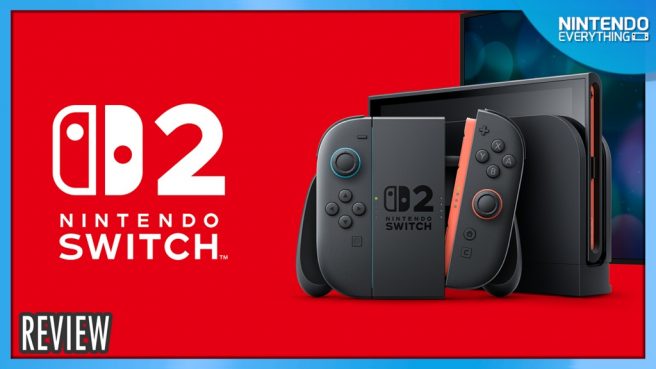Nintendo Switch 2 hardware review
When the original Nintendo Switch launched in 2017, it shook up the very notion of what a gaming console could be, offering unprecedented versatility by allowing players to experience true console-quality gaming both at-home and on the go. Eight years later, the experiment has proven a success. Switch is one of the best-selling gaming systems of all time, boasting a staggering library of both first and third-party games, so it makes sense that Nintendo would choose to iterate on the platform rather than reinvent the wheel for its next console. Enter the Nintendo Switch 2, which finally landed in the hands of players nearly eight years after the launch of its predecessor, boasting more power, a bigger screen, and a few quirky new features.

While media outlets (including us) didn’t receive the Nintendo Switch 2 prior to its official launch date, now that the system has been out a few weeks, all of us here at Nintendo Everything have had a lot more hands-on time with the new hybrid console. While it’s easy for people like us who are passionate about games to get swept up in the excitement that comes alongside the launch of a new console, I’ll offer the caveat that these days more than ever, platforms are constantly evolving and receiving new features through software updates and the like. In other words: this review represents how this writer feels about the console at its launch, but the true measure of whether a console will achieve what it sets out to do can shift as time passes and games release.
As someone who has been actively playing the original Nintendo Switch since launch, on paper Switch 2 is exactly what I wanted to them to make. It’s the same concept as the original – a hybrid console that can be played at home or on-the-go – but with a more refined design, and the horsepower to keep up with more demanding modern games. I loved my original Switch (and the OLED model revision was even better), but over the past few years the console has struggled to keep up with the graphical demands that modern AAA games require, and even some Nintendo games have had performance issues. The original Switch also had several issues with build quality, and so at this point there were many people hankering for a more “premium” feeling console from Nintendo. Nintendo, to its credit, understood that this is what people wanted, and gave us pretty much exactly that.
Taking the system out of the packaging for the first time, I was immediately impressed by the look and feel of the new console. Nintendo Switch 2 is a snazzy-looking machine, with it’s sleek, matte-black finish accentuated with understated pops of color. Both the tablet portion of the device and the Joy-Con 2 controllers are built of a soft-touch plastic with just the subtlest bit of texture to it, and it feels excellent in the hands. I’m hopeful that these new Joy-Con will be more resistant to sweat and grime as a result, and so far they seem to be much more resistant to accumulating fingerprints and oils than their predecessors.
The bigger size of the controllers makes them much more adult-friendly; they fit much more comfortably in my hands, although they’re still not quite as ergonomic as the Steam Deck’s molded grips. All the buttons are just a bit bigger, too, most noticeably the triggers and the SL and SR inputs on the inner rails of the Joy-Con 2. That makes a huge difference not just for games that use those buttons, but to give a more solid grip on the system in handheld mode. We still don’t have analog triggers on Nintendo Switch 2, which is a disappointment. Considering that this system is likely to continue to get ports of racing games and first-person shooters (I hope), it would have been nice to have. The PlayStation 5’s adaptive haptic triggers are best-in-class and add a considerable amount of immersion for me when their features are fully implemented, so I would have liked to see comparable tech in these new controllers, but oh well.
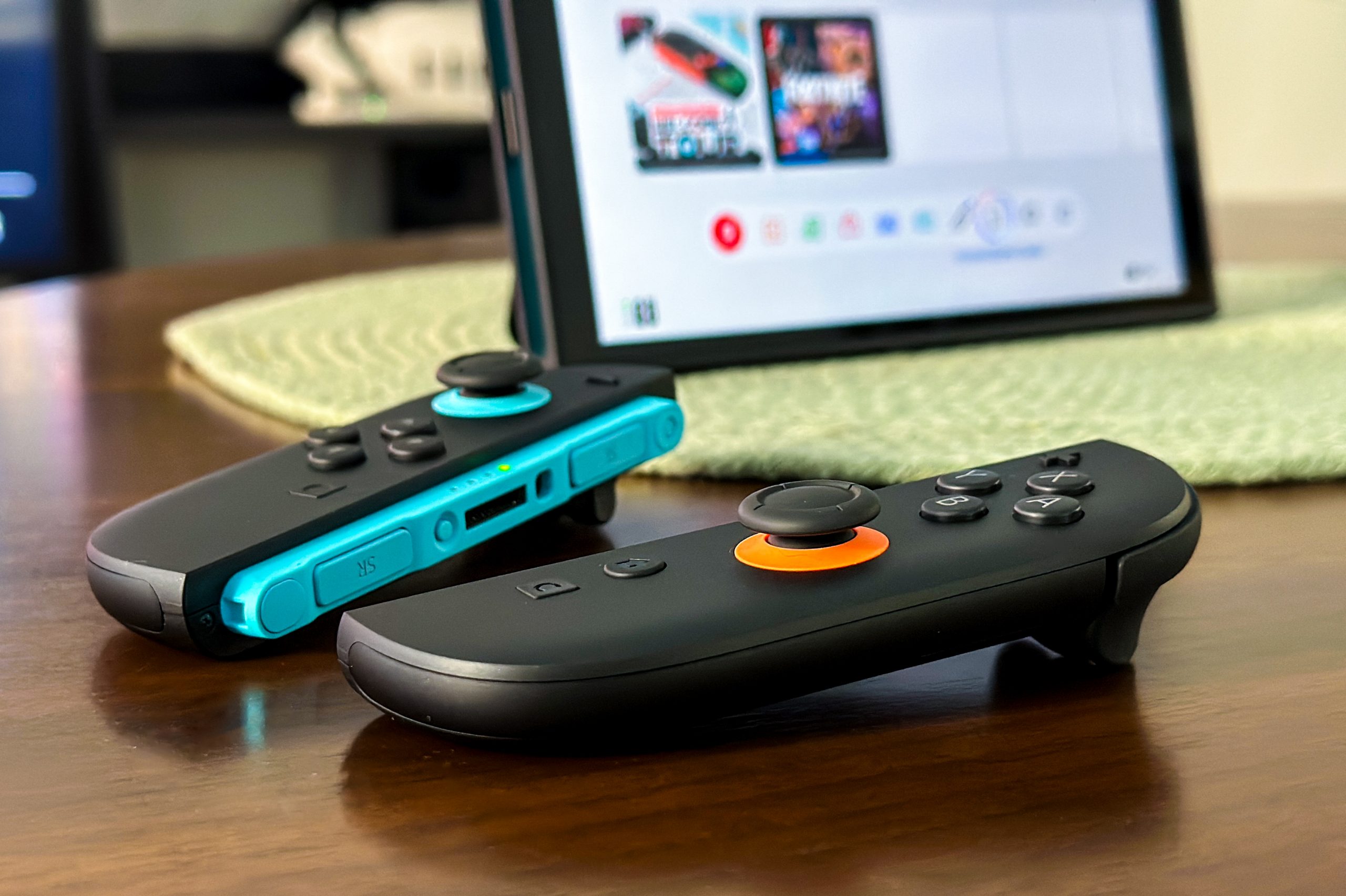
The face buttons feel satisfyingly clicky with just the right amount of travel, and the larger analog sticks have a little bit more range of motion to them, which I noticed immediately made precise movement easier in games. That said, I’m a little concerned that the new sticks could be more prone to issues. My concern lies in the fact that that the black rubber cover at the base of the sticks does not seem to extend far enough down over the pivot mechanism – so when the stick is fully moved to one side, it’s actually possible to glimpse into the mechanism of the stick itself. It seems like it’s just waiting to collect dust in there, although I hope I’m wrong. Some folks have also reported online that the rubber cover has actually managed to get wedged in the stick mechanism, although it’s easy to get it unstuck by quickly rotating the sticks. So while it’s certainly not a big deal, it seems like an issue that could have been avoided with a better design.
Beyond that, the other big new change with the Joy-Con 2 controllers is how they attach to the system itself. The sliding rail mechanism of Nintendo Switch 1 has been replaced with a magnetic attachment system, and the new controllers simply snap on and off with a very satisfying sound. It’s a massive improvement, because while the process of attaching and detaching the controllers now feels effortless, when they are attached they also now feel significantly more sturdy. No longer do I have to worry about the cheap plastic of the original Joy-Con wearing down against the system’s metal rails, causing my controllers to slide off my system during a play session (a common issue with the launch Nintendo Switch models). When attached, these new controllers have zero wiggle or give, so playing in handheld mode feels significantly better. The Joy-Con 2 controllers also feel very good in the included grip attachment, to the point where I have zero desire to buy a Pro Controller.
The final big change to the new controllers is the optical sensor on the inner rail of each one, which allows players to use the new controllers akin to a computer mouse. This is exciting as in theory, many game genres – from first-person shooters to complex building and management games – can benefit from the precision a mouse brings to the table, as PC gamers are well aware. In Nintendo Switch 2 Welcome Tour, one of the launch titles for the system, it feels very easy to use. A simple minigame that had me controlling a spaceship and dodging incoming obstacles was a great showcase for the level of precision that is possible when using this control scheme. A friend who has been playing the Nintendo Switch 2 port of Cyberpunk 2077 also had great things to say about that game’s mouse mode, allowing for responsive aiming when shooting foes that can surpass what is possible on a controller.
As soon as one places the Joy-Con 2 down on its side, mouse mode automatically activates, and it only requires very small movements. This is great, as I was able to easily use the control scheme on various surfaces: my leg, a couch cushion, the armrest of my sofa… so having a desk in front of you doesn’t seem necessary at all to use the new features. I do recommend using this control style with the new wrist straps for the Joy-Con 2 controllers, as the straps have glide pads on the bottom that will help avoid scuffing up the controllers themselves when sliding them around.
Moving onto the tablet portion of the device, we now have a noticeably bigger 7.9 inch LCD display on the front, clocking in at a wonderfully crisp 1080p. While initially I was disappointed that Nintendo didn’t splurge for an OLED panel, now that I’ve actually played some games on this thing, I can confidently say that this is the nicest display I’ve personally ever seen on a dedicated handheld gaming device. It’s sharp, very bright, and has the ability to reproduce very vibrant colors that honestly don’t have me missing my Nintendo Switch OLED at all. Nintendo Switch 2 games simply look immaculate on it, and the sheer size of the thing combined with its higher resolution absolutely results in a more immersive experience when playing in handheld mode. The screen also supports HDR, allowing for more realistic lighting effects in supported games, and it additionally has a 120hz refresh rate, meaning that games that run at high frame rates will look buttery smooth on the display (although not many games are hitting that frame rate at launch).
Playing in tabletop mode on the Nintendo Switch 2 is also a much more pleasant way of experiencing games than on the original model. The new kickstand looks flimsy, but feels quite sturdy in practice, requiring a decent amount of force to extend. It has a really wide range of motion, so I was always able to get the console positioned in a way where I could be confident it was sturdily placed. And if you, like me, enjoy occasionally rotating the system on its side to play supported games in a vertical screen orientation (Downwell fans know what I’m talking about), this is a much safer way to do that without having to worry about the system toppling over. Finally, as someone who enjoyed placing my Nintendo Switch 1 on a tray table during a long flight to crank out some gameplay hours, I’m also grateful for the addition of a top-mounted USB port to make charging easier when playing in tabletop mode. (That is also where the Switch 2 camera can be connected when playing in docked mode, and other USB cameras may work with the system as well.)
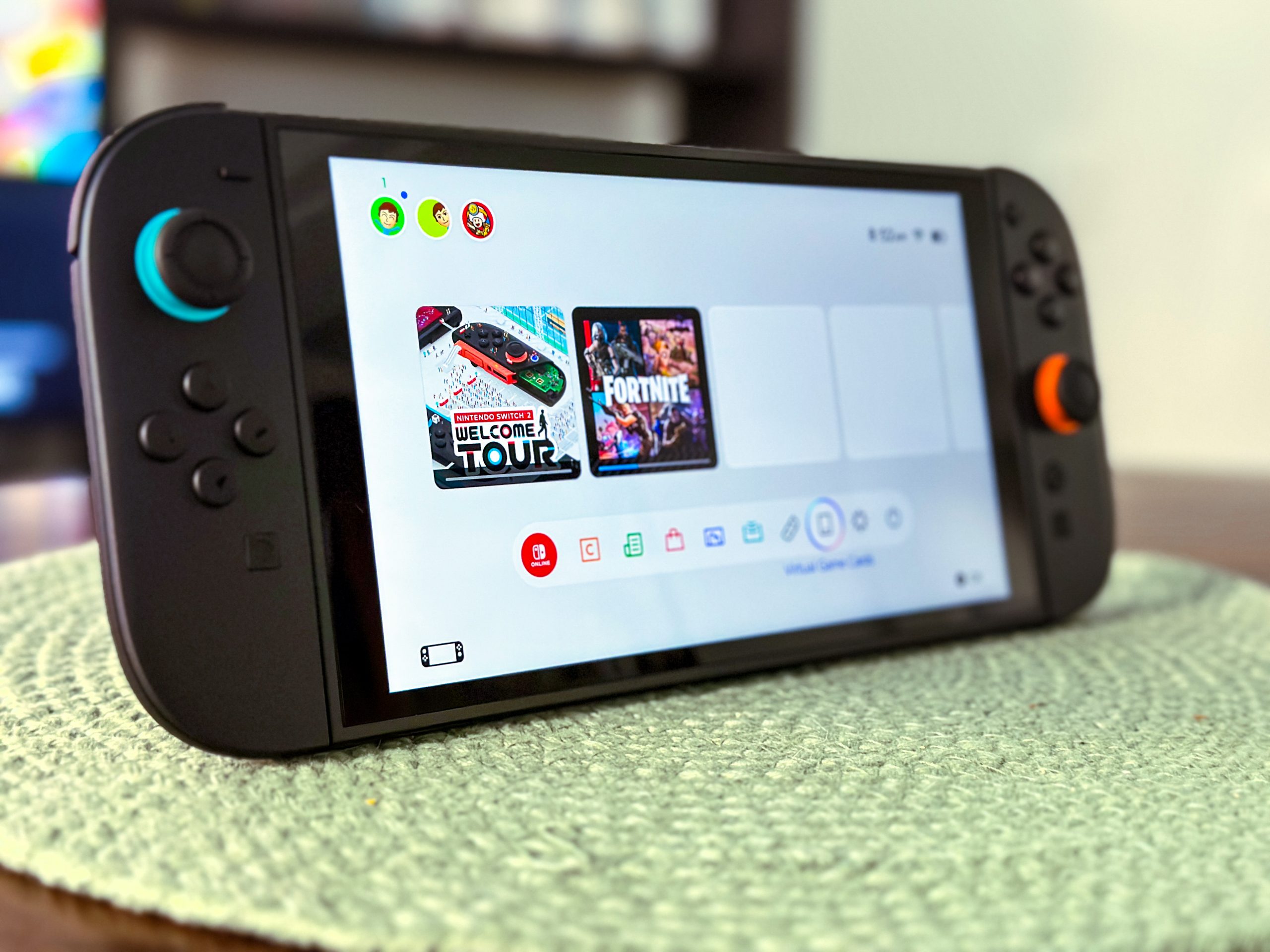
In docked mode, Nintendo Switch 2 is even more of a powerhouse than before. Finally, after what feels like an eternity, we have a Nintendo console that can output games at 4K resolution, with high frame rates and HDR support. There’s little to say about the dock itself, which remains a pretty straightforward hunk of plastic designed to connect the system to a TV. It’s a bit heavier, and feels less likely to slide around when docking and undocking the console, but beyond that it’s the least exciting part of the system to interact with.
The system’s launch lineup certainly paints a promising picture of what this console is capable of, and the new releases that this reviewer has been playing have been nothing short of stunning. Mario Kart World is one of Nintendo’s best-looking games ever, packed with charming details and vibrant locations that pop off the screen, and the HDR support and high frame rate (in most gameplay modes) makes it a joy to play. No Man’s Sky, which required major graphical concessions on the original Nintendo Switch, looks like a completely different game on Switch 2, with vastly improved textures, models, lighting and draw distance. Fortnite, which I would argue was borderline unplayable on the original Nintendo Switch, now largely looks and plays like its PlayStation and Xbox counterparts, minus perhaps a few missing effects here and there. And Fast Fusion, a Nintendo Switch-2 exclusive sci-fi racer akin to games like WipeOut, has both performance and fidelity-focused graphics settings that result in a stunning, white-knuckle racing experience that feels nothing short of futuristic to experience.
Ultimately, it will still be on developers to learn how to best utilize the power that the system offers, and inevitably some games will do better than others. Street Fighter 6, which I’m currently reviewing, is a more mixed example. While the core fighting modes like Versus, Arcade and Online matches all run essentially flawlessly, that game’s World Tour mode – which let’s the player explore a small open-world, get into street brawls and interact with characters around the environment – often looks downright ugly at times, with blurry textures that suffer from prop-in, a questionable frame rate, and really bad lighting. For other ports like Hitman: World of Assassination, the broad consensus seems to be that it’s an impressive port for a console like Nintendo Switch 2, but that it’s clear minor compromises had to be made to certain visual elements to get the game running as well as it does. In other words, just because Nintendo Switch 2 is more powerful, that extra juice isn’t necessarily a magic bullet. Still, the exciting reality is that the console will just be able to run so many more games that would never have been possible on the last system. The fact that CD Projekt Red was able to fit the entirety of Cyberpunk 2077 on this thing is a great sign for what this system can do.
Unfortunately, all that power comes with a big trade-off: battery life. As with Nintendo Switch 1, it will very much fluctuate depending on a variety of factors, including what game you’re playing, how bright the screen is, whether you’re connected to a wireless network, and more. Nintendo estimates the battery life to be between 2 and 6 hours, which is a pretty big range. Unfortunately, in my experience so far, most of the games that people are really excited to play on this thing – graphically demanding games like Cyberpunk – are going to drain the system quickly. I’m consistently getting around 2.5 hours with games like Mario Kart World and Street Fighter 6, and this isn’t even at max screen brightness. Backwards compatible games that are less intensive on the hardware will last longer, but I have yet to run into a Nintendo Switch 2 native game where I’m getting above 4 hours on a charge, and most games I’ve tested are coming in much lower than that. In fairness, the launch version of Nintendo Switch 1 had similar issues that were revised with both the V2 and OLED versions of that console, but it’s really rough coming from that to this.
In fairness, this may not be a concern to everyone. Plenty of people aren’t sitting down to play a game in handheld mode for more than two hours at a time, I’m sure, but for folks who travel a lot (including myself) it may be more of an issue. Yes, I always bring a charger with me, but Nintendo Switch 2 doesn’t charge very fast, and unless you are using something comparable in output to the included AC adapter, the system will likely drain faster than it charges in most occasions. Some people are fine carrying around a bulky battery pack in their bag to get an extra charge on the system, but plenty of people don’t want to do that, including myself. I also don’t always want to be playing in airplane mode, unable to use my Bluetooth headphones, at minimal screen brightness with HDR turned off. Again, I recognize that this is the tradeoff for more power, but I would have been okay with a slightly thicker and heavier system if I could use it for longer.
I do also think it’s possible the system’s 256gb of onboard storage will fill up more quickly than some may hope. Some games are already pushing 80 GB, like Split Fiction, although there are plenty that are closer to 25-30 GB (or less). I would have liked even more storage onboard, but luckily the system has a MicroSD express slot under the kickstand, so there’s a way to affordably add more storage over time as needed.
Still, the fact that I can take my console out of the dock, throw it in my bag (in a case, of course) and continue playing these modern games on the go feels more impressive than ever considering the power this thing holds. And as much as I love my Steam Deck, the way Nintendo Switch 2 suspends and resumes games so effortlessly makes this sort of hybrid device experience unmatched. Can you get more power by buying a Lenovo Legion Go S or something similar? Probably, but the actual experience of using the darned thing just doesn’t compare with the level of polish that has gone into the Nintendo Switch 2. Right now, it just doesn’t feel like there’s a more effortless way to play console-quality games on the go.
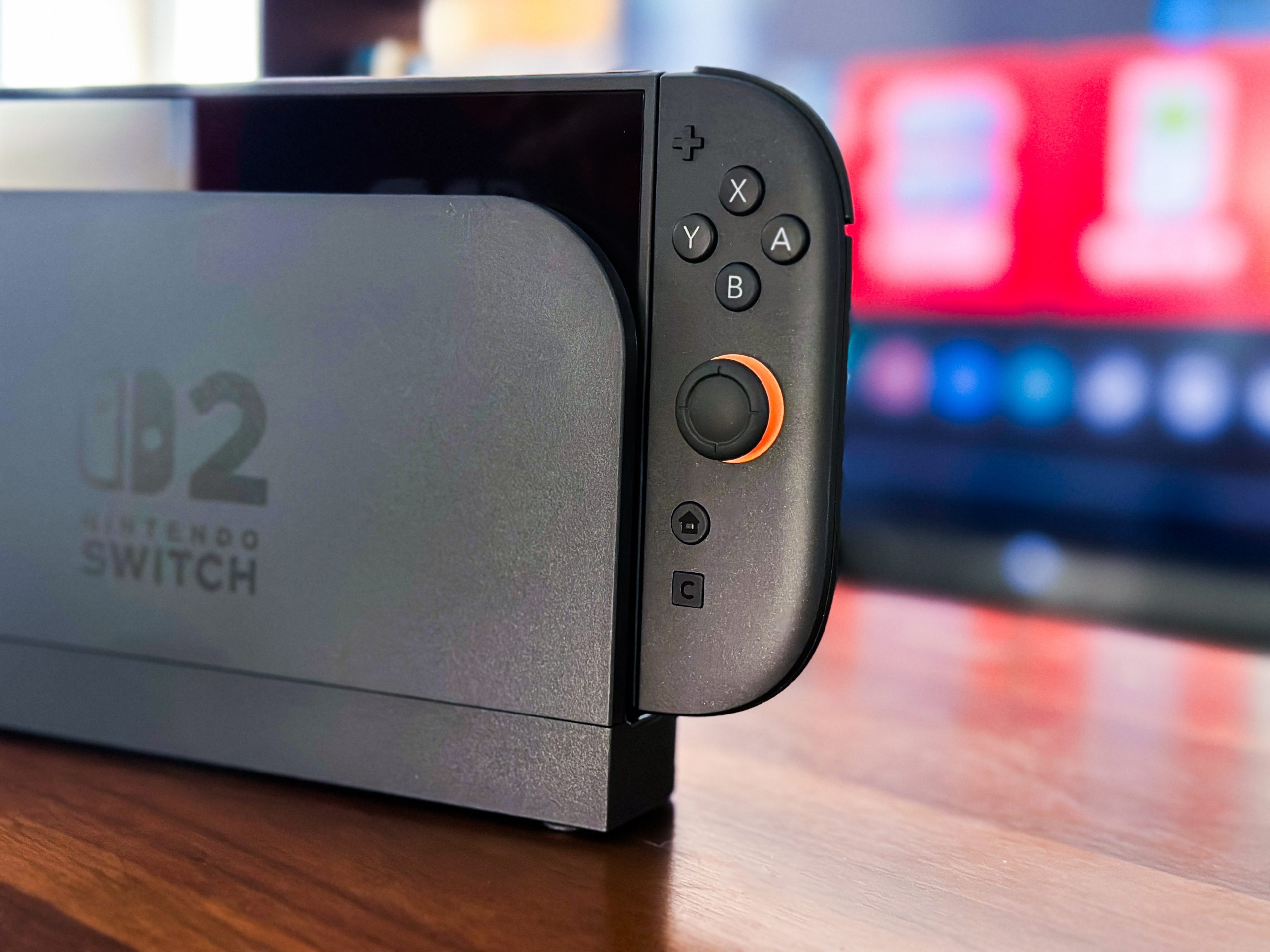
I’ll caveat this by saying that I’m currently a bit mixed about how Nintendo has implemented backwards compatibility. I’m very grateful that it’s here, and that the vast majority of Nintendo Switch games are not only supported, but can run better in many cases. Titles that were intended to run at a solid 30 or 60 frames per second on Nintendo Switch 1, but experienced frame drops, seem to often have those stutters smoothed out automatically thanks to the additional horsepower of the new system. This was the case for me in Bayonetta 2 and 3, which were among the first games I tested on the system, and it is very nice for intense titles like that.
That said, I’m concerned is that blowing up a 720p game to 1080p on Nintendo Switch 2’s handheld display is a poor implementation of backwards compatibility, as it seems to (at least in some cases) increase aliasing and make existing visual defects more noticeable. That’s just kind of what happens when you run an older game on a better screen without upscaling, but I feel like there was a missed opportunity here. Shouldn’t it be possible to run Nintendo Switch 1 games using their original docked settings in handheld mode on Switch 2? The system is certainly powerful enough to do exactly that, and having this feature as a toggle would make it a non-issue for games with weird docked-mode control schemes. Regardless, that feature currently doesn’t exist, so my first impression of backwards compatibility is that there are trade-offs that may make some players be tempted to keep their previous systems around for certain games. I’ve gotten more used to it over time, but in my opinion, most Nintendo Switch 1 games look just a little bit worse for wear on the Switch 2’s screen—even if the frame rate is improved.
Nintendo Switch 2’s OS is almost identical to the previous device’s OS from both a visual and functionality standpoint, although there are plenty of small tweaks to improve usability. Basic things that should have been there on the original Nintendo Switch, like the ability to set a passcode on the lock screen, have been added, and the eShop is now significantly faster (and, dare I say it, even fun) to navigate. There are plenty of other small tweaks, like making it easier to send screenshots from your system to your phone. Overall, though, there’s nothing fussy about the system software – it just wants to show you your games and let you start playing as quickly as possible. And I appreciate that, even though I do miss some of the whimsical OS theming of Nintendo’s older consoles, like the Wii and 3DS.
The biggest new feature added to the OS is GameChat, which is so tightly integrated into the functionality of the system that the right Joy-Con 2 controller has a dedicated button to activate it. GameChat is Nintendo’s solution (finally) to allow talking with friends on the system itself; no longer is there a need to download a half-baked smartphone app to do something that other consoles have been doing well for over 15 years. Not only does Nintendo Switch 2 support voice chat with the console’s onboard microphone, it even supports full-on video calls with friends by hooking up a supported USB camera.
My first impression of using GameChat so far? It’s awesome. This is coming from someone who does not traditionally play a lot of online multiplayer with friends, but it’s really impressive just how seamless Nintendo has made this feature. It only takes a few clicks to turn on a call with friends, and its really cool having the option to actually see each other while playing a game with them. It makes online play feel more like couch co-op than ever before, and because it works at the hardware level, you and your friends can be playing totally different games if you want.
There are a ton of little features that exemplify the thoughtful approach Nintendo has taken in designing GameChat. You can share your gameplay onscreen with friends, or not. You can activate an option to view your friend’s cameras while playing, or not if you’d rather just focus on the gameplay. If you have a camera attached, you can change the field of view, or turn on face-tracking so you don’t have to show your entire cluttered apartment to your friends. When you talk, the system will subtly lower your game audio so it isn’t picked up over the microphone, but not to the extent it’s annoying. The microphone actually works really well, too – even from ten feet away, it had no issues clearly picking up my voice. There’s certainly room for small improvements to be made down the road, like letting additional people join a call without having to restart the whole chat session, but by-and-large this is the coolest suite of social features I’ve experienced on a console in quite some time.
Another feature I enjoyed testing is GameShare, although in practice it’s not something I imagine myself using all that often. The idea here is that for supported games, if a friend or family member is in the same room with you and also has a Nintendo Switch 2 or Switch 1 console, select multiplayer games can be played locally even if that person does not own the game. It’s basically a modern take on something like DS Download play, except the difference here is that Nintendo Switch 2 is essentially streaming a local gameplay session to a nearby console. I tested this out with Split Fiction, giving my wife my Nintendo Switch 1 console and starting a session so she could play on her own screen. It worked okay, but the systems do have to be pretty close to each other to avoid major latency or drops in resolution. I’ve heard it works better between two Nintendo Switch 2 consoles, but as I only have one on-hand, I wasn’t able to test it at that level.
One additional improvement I noticed right away (and am very grateful for) is that Bluetooth audio support is so much better this time around. When that feature was patched into Nintendo Switch 1 after launch, it came with some technical limitations: playing with detached Joy-cons while also using Bluetooth earbuds would result in severely degraded audio quality, making it sound hollow and tinny. That is no longer the case on Switch 2, meaning I can now comfortably kick back for a late night gaming session with my AirPods without feeling like I’m sacrificing a key part of the experience.
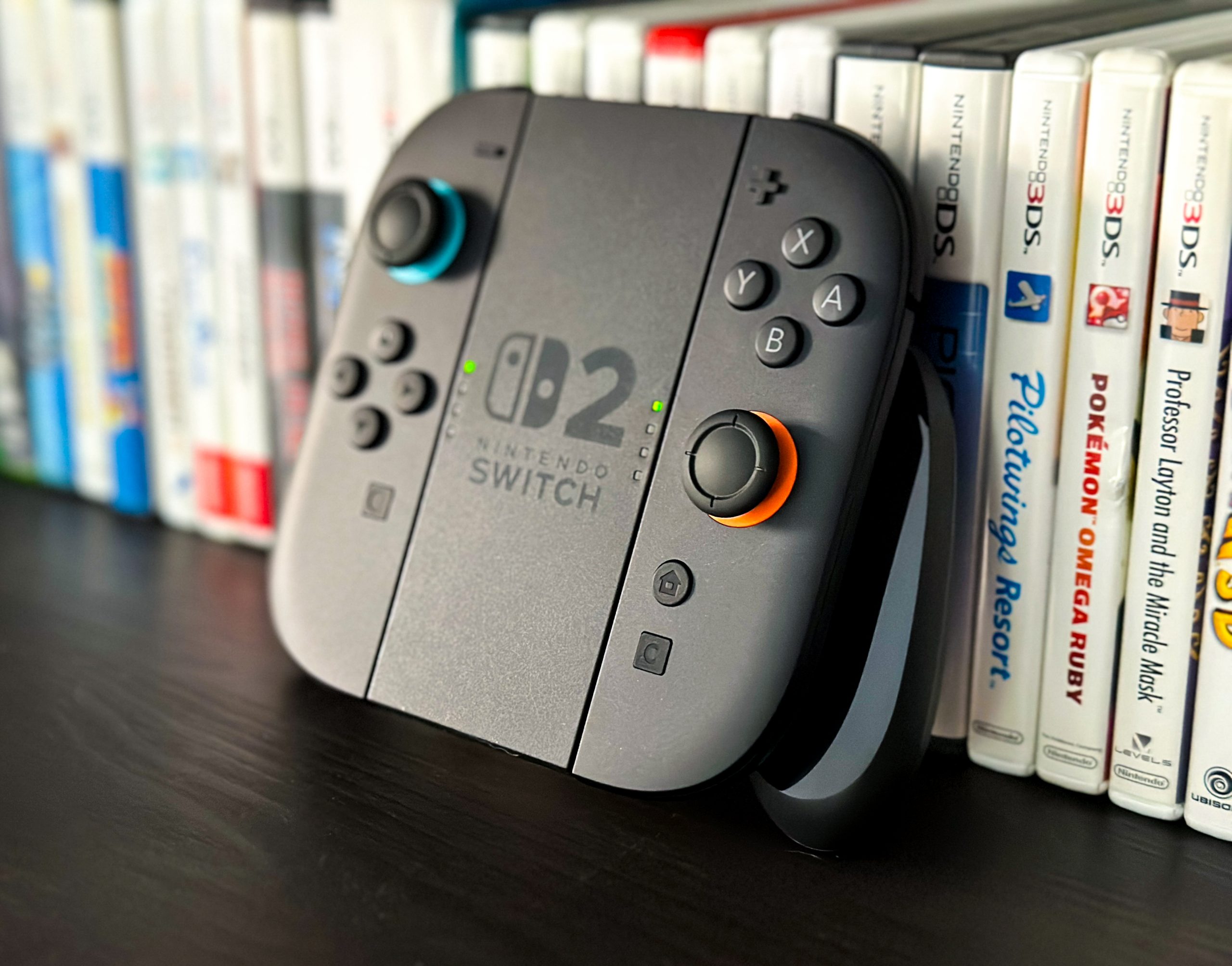
So, where does all that leave the Nintendo Switch 2? Setting aside the price of the system, I think it’s perhaps the easiest product Nintendo has had to sell in quite some time. At this point, most people who are familiar with the modern gaming landscape understand what the Switch concept is, and the potential way a hybrid console can fit into their lifestyle. Nintendo has proven over the past generation that it can output a steady stream of high-quality, first party titles that sell these systems and resonate with a broad audience. Inevitably, it’s very likely that despite any issues that may arise, this thing is going to sell tens of millions of units over the course of its life, get more than enough games for the average player to enjoy, and probably manage to find some ways to surprise us all here and there. Nintendo Switch 2 was poised to be a success at a conceptual level before it even released.
Overall, Nintendo Switch 2 makes a remarkably strong first impression. It’s not perfect – no tech device is – but it does a lot of things right. The grievances I do have – backwards compatibility, and battery life – do mean there is room for improvement, and like Nintendo Switch 1, I’m sure the platform will continue to evolve over time. At the end of the day, a console is only as good as the games it can play, so my hope is that the extra juice this machine is packing will result in a generation of must-play games. But if this is really going to be the device I’ll be using for the next eight years to play first-party games, ports of blockbuster games, lengthy RPGs, and innovative indie titles? I’m happy with that. For what’s essentially an upgrade of a familiar idea, the Nintendo Switch 2 is just about everything it needs to be, and that’s exciting.
